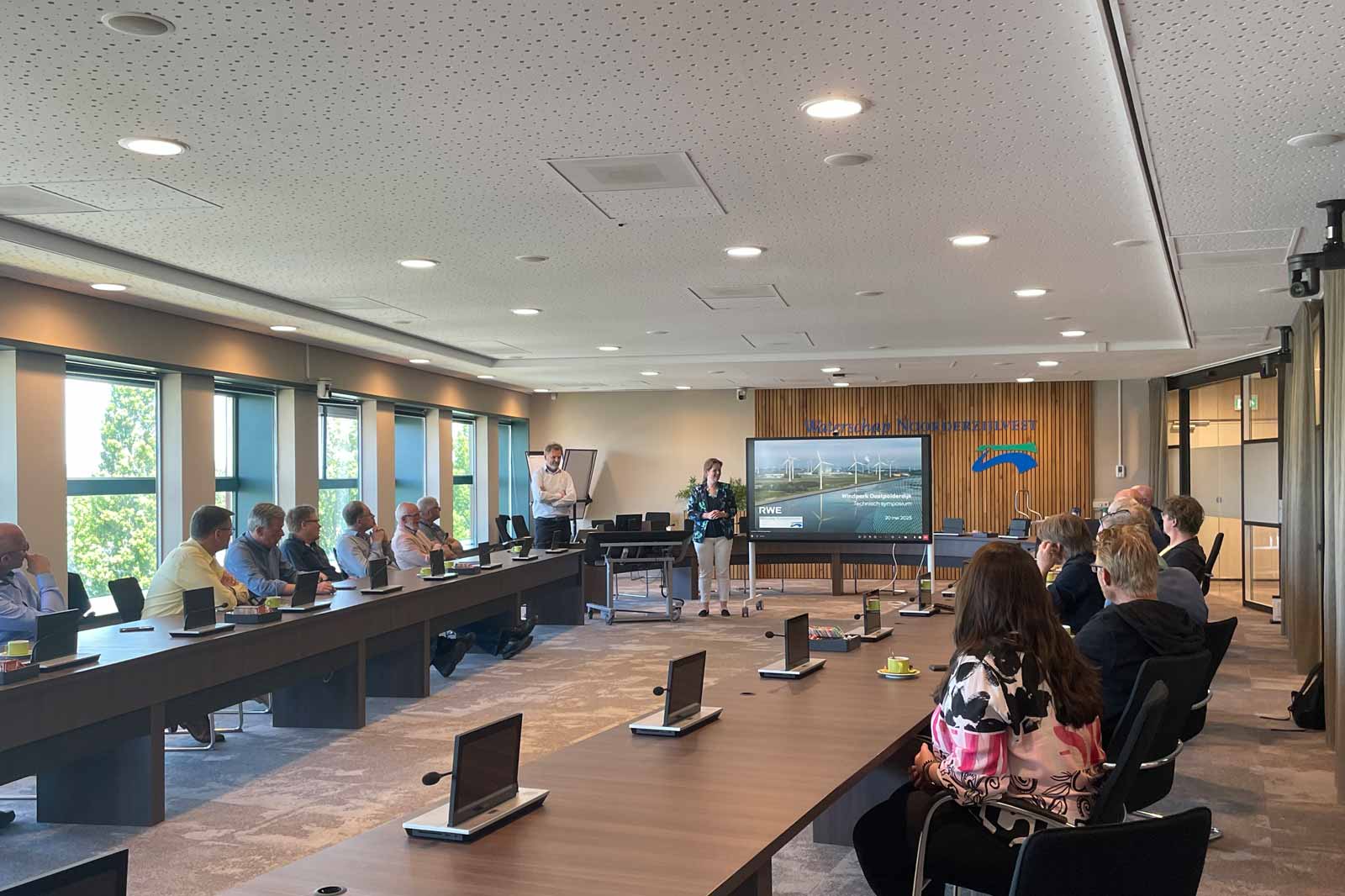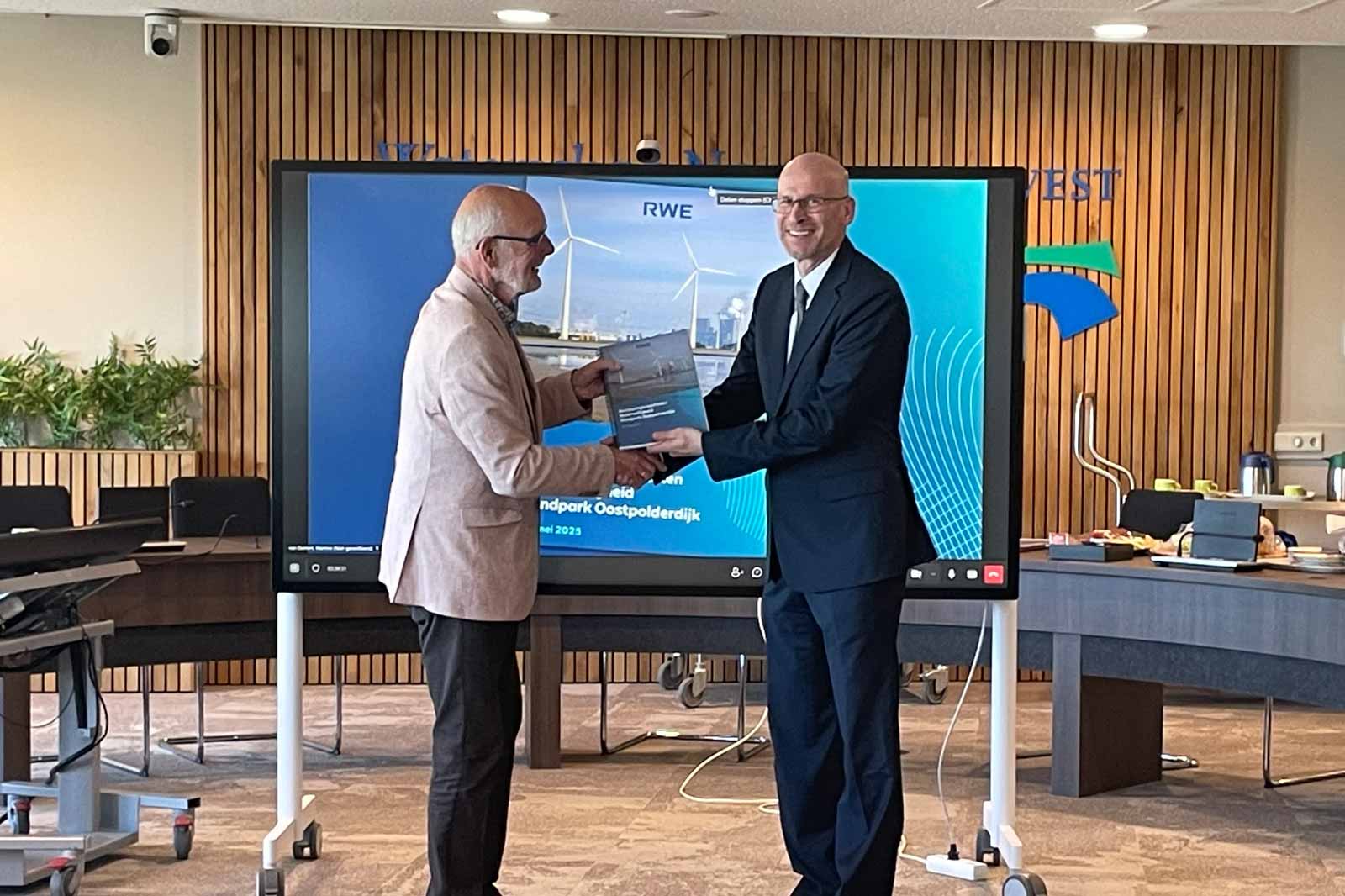In recent years, RWE and Waterschap Noorderzijlvest have taken on a special challenge: the realisation of Windpark Oostpolderdijk in Eemshaven, a first with wind turbines on a primary flood defence adjacent to the Eems-Dollard. A unique and innovative project that has never before been carried out in this way.
During the technical symposium ‘Energierijke Dijken’ on 20 May last, RWE presented the results of the extensive monitoring carried out during the construction and operation of the wind farm. The focal points were water safety and environmental impact. The monitoring results were officially handed over to Noorderzijlvest Water Board by RWE.
Retrospective
Martine van Gemert (Developer at RWE Renewables) and Jan-Willem Nieuwenhuis (Water Safety Policy Advisor at Noorderzijlvest Water Board) are the driving forces behind this special project. They look back on a ten-year trajectory that began in 2011 and culminated in the commissioning of three wind turbines in 2022. Both technical issues and uncertainties made the development phase challenging.
‘At the start of the project, it became clear how little is known about wind turbines and their effect on the subsurface,’ says Martine. ‘Water safety is of course always paramount with dykes. In addition, the surroundings had to be taken into account, including proximity to the Wadden Sea, birds, pipes and the composition of the dike. In short: challenges! Good cooperation and perseverance were very important here. And, of course, the commitment of the many partners, such as ABT for the foundation design and Arcadis for the water safety test. Because before the turbines could be built, a lot of research was needed.’
Before the water board could give the final green light for the realisation of the wind farm, the design and the underpinning water safety was even tested and found to be robust by the independent, national Water Safety Expertise Network (ENW). This also confirmed by ENW that, in a broader sense, wind turbines on primary flood defences can be realised responsibly under the right conditions. This offers great opportunities in our country, which has some 3,600 kilometres of primary flood defences!
Monitoring: a necessary basis
As the construction of wind turbines on a primary seawall had not been realised before, a comprehensive monitoring obligation was included in the permit conditions. Jan-Willem Nieuwenhuis stresses, ‘Safety was paramount from day one. Among other things, earthquake resistance, water safety and the impact of heavy storms were thoroughly investigated. Especially what would happen below the turbines was unknown. With this kind of special projects, the general rule applies: Measuring is knowing!’
Otto Heeres, senior consultant at Arcadis, explained the importance of vibration measurements and gave insights into how the turbines affect the subsurface. The results of the monitoring supported the feeling that it should be possible to build wind turbines on the primary flood defence without compromising water safety.
Knowledge gained
Actual monitoring once again showed that simply extrapolating to extreme situations does not always match reality. Thus, to our surprise, a less severe storm actually resulted in stronger underground effects.
Separately from this project, the national Knowledge Network Wind Turbines near flood defences was set up. Under its guidance, a guide has been drawn up focusing on the administrative, legal and technical issues involved in placing wind turbines on or near a primary flood defence. The Oostpolderdijk wind farm was an important basis/test case for this. Sharing knowledge through the knowledge network is essential for a follow-up of this first wind farm on the Oostpolderdijk at other locations.
The monitoring report handed over contains measurement data from three consecutive years showing that the placement of wind turbines on a flood defence dike has no negative impact on the dike body. The report also contains measurement data acquired at the time of the February 2022 ‘triple storm’. With flying colours, both the wind turbines and the dike body withstood this series of storms. Based on the measurements, optimisation was even made in the turbines' operations to further reduce the impact on the barrier.
After the official part of the meeting, interested parties and stakeholders talked about the possibilities of wind energy on dykes in the future.
Want to know more?
More information about Windpark Oostpolderdijk can be found here. Interested in the full report? Please contact us.
Laurens van Zelst (Director RWE Renewables Benelux): ‘Compliments to the team of go-getters who made this possible. A unique project, with potential for the future, showing that ‘out of the box’ thinking pays off.’
Herman Beerda (Daily board member Waterschap Noorderzijlvest): ‘As a water board, cooperating on this wonderful project fits perfectly with our ambition to be energy-neutral from 2025 onwards. This way, we too contribute to the energy transition.’

